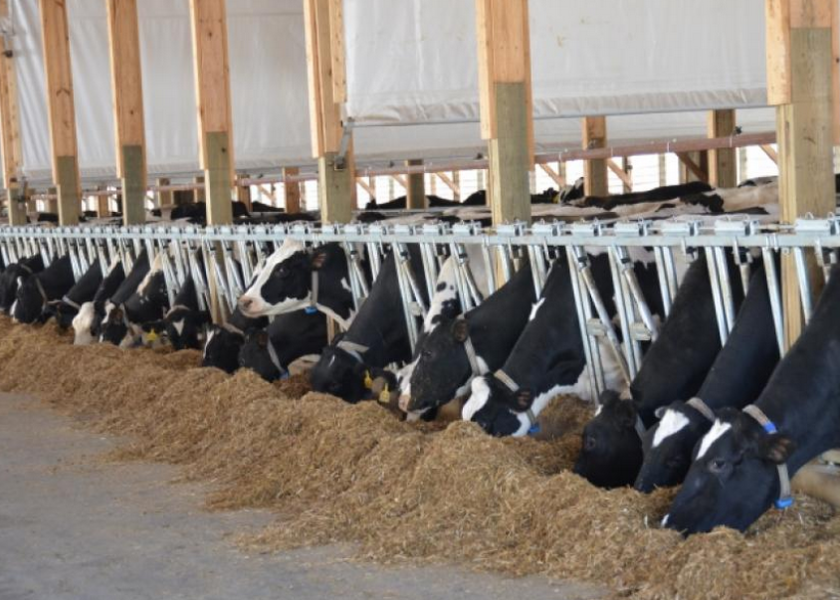Pay Attention to Dairy Cow Stocking Density

In a dairy free-stall barn, stocking density is most typically defined in terms of cows per stall or used as a percentage. For example,1 cow/stall is equal to a 100% stocking density and 1.3 cows/stall is equal to a 130% stocking density. Stocking density is an important number to pay attention to because stocking density affects cow behavior, how a cow uses its time, and stocking density affects cow health and milk production. In short, stocking density has an impact on the economics of a dairy operation.
To understand how stocking density can affect a dairy cow, you have to know something about how a dairy cow ideally will budget her day in terms of time given to certain activities. In a February 13 webinar to Ohio dairy producers, Peter Krawczel from the University of Tennessee, Animal Science Department talked about stocking density, cow comfort, and cow productivity. According to Krawczel, in a healthy environment, the typical lactating dairy cow spends 3 to 5 hours /day eating, about 0.5 hours/day drinking, 2 to 3 hours/day in socializing, walking, grooming, and estrous activity, and 10 to 14 hours /day lying and resting, which leaves 2.5 to 3.5 hours/day for milking. When you look at that time budget, you can see that lying and resting time is very important in the life of a dairy cow. So obviously, anything that negatively impacts on that behavior is probably going to impact on health and milk production.
The amount of time a dairy cow spends lying down and resting is not because the cow is bored and there is nothing else to do. It is necessary for cow health and productivity. How important is this time? During his webinar presentation, Krawczel talked about studies done to evaluate the importance of rest to dairy cows. When dairy cows are deprived of that 10 to 14 hours/day to lie down and rest, blood cortisol levels, associated with stress, increased while growth hormone levels, associated with milk production, decreased. In fact, dairy cows will prioritize rest over other daily activities. Cows will sacrifice feeding time and social behaviors to maximize lying/resting time. To get the needed lying/resting time, a cow must have access to a comfortable stall.
Access to a stall goes back to stocking density. An important question is: At what level does stalking density have a negative impact on cow health and milk production? Is there an acceptable level of overstocking? Research that has been done on stalls per cow reveals that it is not necessary to have a strict one cow per one stall ratio, which would be considered a 100% stocking density. Some level of overstocking is acceptable, but generally should not exceed 120% or 1.2 cows/stall.
Barn design and layout can influence the exact number, as well as barn management. As farms exceed that 120% stocking density, milk yield or potential milk production begins to decline, and there can be health issues associated with overcrowding that negatively impact milk production.
Stocking densities of greater than 120% are common on some farms, and there are the stories of farms that maintain stocking densities in excess of 150%, with apparently good herd milk production. Often economics drive overstocking in free-stall barns. The barn facility is a fixed cost. If more cows are put into the facility, the fixed cost is spread over more animals and the cost per head is lower. In times of low milk prices and low returns per cow, there is a tendency to add more milk cows to try to retain the same income level, thus overstocking occurs. Sometimes overstocking occurs because more heifers are being retained for a planned herd expansion.
Until that expansion is completed with the expanded housing, overstocking occurs. Finally, because of the cow's ability to adjust and make sacrifices in overcrowded conditions, the farm manager may not be aware of the decreased milk production potential or the increased health issues. The level of milk production and the health issues has become the normal operating condition.
When stocking densities exceed 120%, cows begin to compete for stalls. This is a stressor. If cows don't get adequate rest time, their immune system can become compromised and they are more susceptible to illness. Often, standing time will increase and incidence of lameness or other foot problems increase.
Krawzcel talked about research conducted on the time to lie down following milking. Ideally after milking, the cow should remain standing or walking around for at least half an hour to allow teat ends to seal and prevent possible mastitis causing organisms from entering via the teat canal. At stocking densities of 100 to 120%, time to lie down after milking averaged 38 to 39 minutes, which is considered very good. At rates higher than this, the time drops to under 30 minutes. Basically, cows know that stalls are in demand and they may hurry a meal or cut out some other activity to grab a stall as quickly as possible. Stocking density of dry cows has health implications as well. In a March 13 webinar, Katy Proudfoot, OSU Extension Animal Welfare/Behavior Specialist, presented some information that showed when cows are crowded in the transition period, the risk of metritis and ketosis in early lactation increases.
A final factor to consider in regard to stocking density is not only cow access to a stall, but cow comfort when a stall is available. Stall bedding must be clean and dry. The stall design and size must be matched to cow size. Paying attention to stocking density with a goal to not exceed 120% can decrease production costs while maintaining or increasing milk production.







